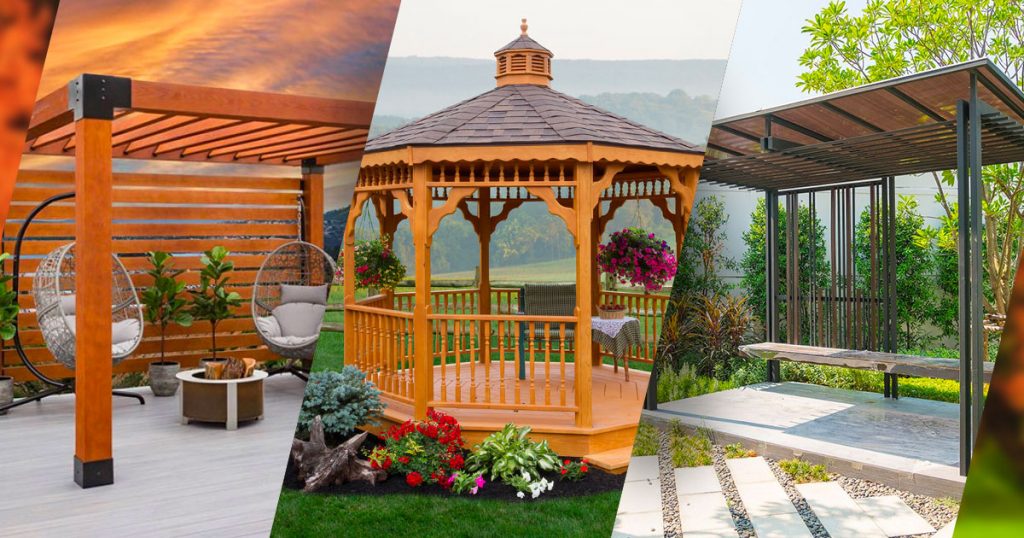Enhance your outdoor living space with structures like gazebos, pavilions, and pergolas, which bring comfort, functionality, and style. Beyond offering a cozy outdoor retreat, these structures elevate the overall aesthetic of your backyard. To help you make the right choice for your space, we’ll delve into the details of gazebos, pavilions, and pergolas, highlighting their unique qualities. So, when it comes to choosing between a pergola, gazebo, or pavilion, we’ve got you covered.
What is a Gazebo?
Gazebo type structures are standalone with a strong roof and vertical posts. They give full shade and shield you from outdoor elements. Usually, they’re built in a traditional way, like a rectangle with a raised part that can be open or divided with walls for privacy. Gazebos are often smaller and great for social events or family gatherings.
Benefits of Gazebos:
- Adaptability: Gazebos offer a multitude of uses, serving as spaces for outdoor dining, entertaining guests, relaxation, and activities like yoga or meditation.
- Visual Charm: With diverse styles and materials, gazebos enhance the aesthetics of any outdoor area, adding visual appeal.
- Weather Shelter: Gazebos provide protection from the sun, rain, and wind, ensuring comfortable outdoor activities even in less-than-ideal weather.
- Property Value Boost: Incorporating a gazebo into your property can elevate its value, as homebuyers often seek this desirable outdoor feature.
Drawbacks of Gazebos:
- Costly Investment: Installing gazebos can be a considerable expense, particularly if you choose premium materials and professional installation services.
- Ongoing Care: Depending on the chosen material, gazebos might demand regular upkeep, like staining or sealing, to maintain their optimal appearance.
- Seasonal Limitations: The usability of a gazebo can be restricted by climate and weather conditions, making it less practical for year-round use.
- Space Constraints: Gazebos occupy a substantial outdoor footprint, posing challenges for smaller properties or those with limited outdoor space.
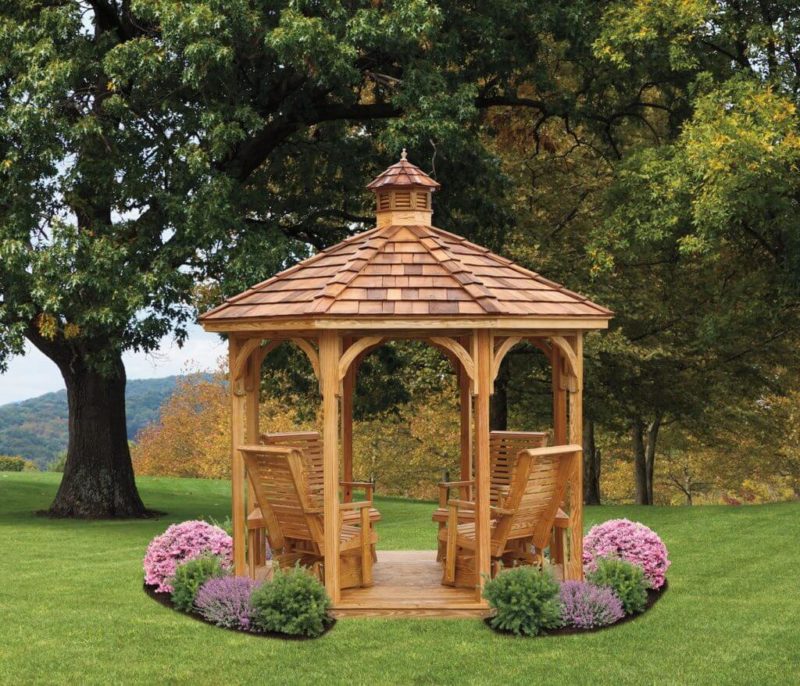
What is a Pavilion?
Pavilions stand out as outdoor structures, providing a covered space for socializing amidst the fresh air. With open walls and a robust roof, they often embrace traditional building techniques, maintaining a classic appearance. Ideal for hosting outdoor events such as barbecues and dinner parties, pavilions offer enhanced protection from the elements compared to gazebos. Their spacious design accommodates a larger number of people, making them perfect for festive occasions like birthdays and even family reunions.
Benefits of Pavilions:
- Good for Outdoor Events: Pavilions prove ideal for outdoor events and gatherings as they provide reliable shelter from both the sun and rain.
- Enhance Your Yard: Elevate the visual appeal of your outdoor area with a diverse range of pavilion styles and designs.
- Versatile: These adaptable outdoor structures serve various purposes, from providing shelter for guests at outdoor events to creating a cool play area for kids or a tranquil spot for adults to unwind.
- Resilient: Durability is a key feature, as most pavilions are crafted from robust materials designed to withstand the elements and ensure long-lasting use.
Drawbacks of Pavilions:
- Expense: Acquiring and installing pavilions can incur significant costs, especially if you opt for a customized design.
- Upkeep: Pavilions, like any outdoor structure, demand regular maintenance to preserve their condition and longevity.
- Seasonal Limitations: Depending on your geographical location, a pavilion’s utility may be restricted to specific times of the year due to varying weather conditions.
- Space Constraints: Pavilions, being substantial outdoor structures, necessitate ample space in your outdoor area, posing challenges for some homeowners.
- Permit Considerations: Building a pavilion may require permits in certain areas, introducing additional costs and potential delays to the installation process.

What is a Pergola?
A pergola stands as an outdoor structure featuring a roof made up of horizontal beams or slats extending between upright columns. Their larger-than-average size allows for a perfect blend of openness, shade, and a touch of seclusion. Pergolas prove to be excellent for hosting sizable gatherings in the garden, infusing a rustic ambiance. When adorned with climbing plants and complemented by a fire pit, they transform into a snug outdoor room, creating an inviting living space.
Benefits of a Pergola:
- Aesthetics: Elevating the visual allure of your outdoor space, pergolas serve as both shade providers and stylish focal points.
- Comfort: Their appeal lies in offering protection from the sun, enhancing the comfort of outdoor activities while ensuring pleasant and inviting air circulation within.
- Customizable: Customizability is a key feature of pergolas, allowing you to tailor them to your unique requirements and aesthetic preferences. You have complete control over the size, shape, and materials, ensuring a seamless integration with your garden.
- Enhance property value: Opting for a well-crafted aluminum pergola kit is a wise investment, given the value it can add to your home.
- Robust: Beyond aesthetics, pergolas boast wind resistance, with the ability to withstand gusts of up to 120 mph, adding a durable and reliable element to your outdoor space.
Drawbacks of a Pergola:
- Shade Constraints: While pergolas offer partial shade, they might not suffice during the sun’s peak hours. This issue can be addressed by acquiring additional sun shades specifically designed for pergolas.
- Maintenance Considerations: Pergolas, depending on the chosen material, may demand consistent upkeep to retain their optimal appearance. For instance, wooden pergolas require periodic staining or painting to ward off rot and insect damage. This is why we often recommend modern pergolas as a contemporary alternative to traditional ones.
- Protection Limitations: Pergolas fall short in providing as much shelter from the elements as gazebos or pavilions. Their inability to be fully enclosed makes them less suitable for use in all weather conditions, although this depends on the pergola’s material and manufacturer.
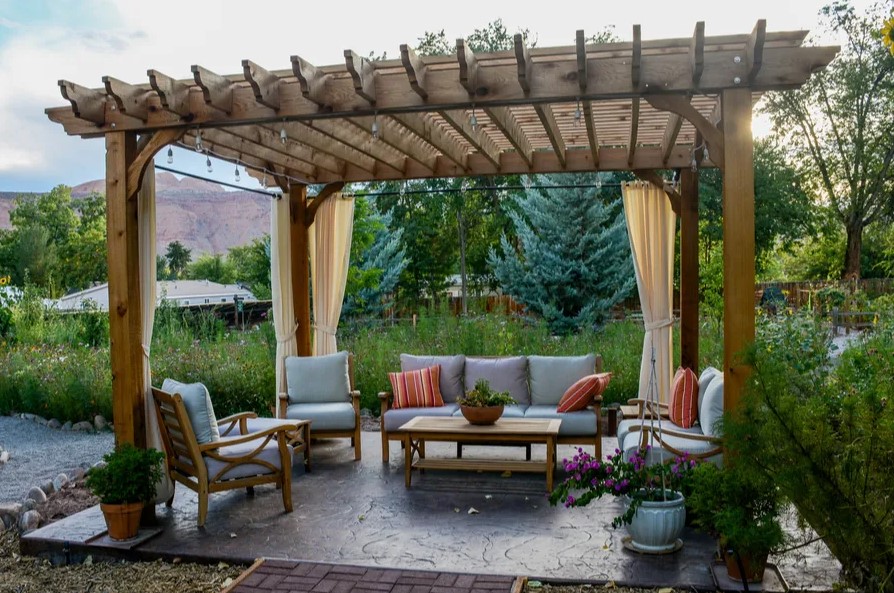
Gazebo vs Pavilion
When choosing between a pavilion and a gazebo, consider your requirements, aesthetic preferences, and tastes. Both provide shaded outdoor areas but differ significantly. Pavilions, ideal for weddings and business events, are larger and suitable for outdoor kitchens and eating spaces, offering strong protection against sun, wind, and rain. Gazebos, on the other hand, are great for informal family events and relaxation, providing design flexibility with various sizes and styles.
While pavilions need more regular upkeep due to their size, overall shape, and substantial roof structure, gazebos may require additional cleaning and sealing for exposed wood components. Ultimately, the choice depends on your needs, tastes, and budget, with pavilions suitable for larger entertaining spaces and robust weather protection, while gazebos work well for smaller, intimate groups or as charming garden features.
Gazebo vs Pergola
The main difference between pergola and gazebo is that gazebos come in circular, hexagonal, or octagonal shapes with a domed ceiling, varying in size from a few seats to a full outdoor living area. They’re great for outdoor dining, resting, and parties, offering full protection from sun, rain, and other elements. Pergolas, typically rectangular or square with an open top and criss-crossing beams, provide partial shade and are ideal for connecting to other outdoor structures.
Gazebos are often made of wood or metal, adorned with balustrades or lattice screens, while pergolas, simpler in design, support plants like roses or vines. Gazebos tend to cost more due to their larger size and complex construction. When choosing between them, consider your finances, landscape structure, needs, and style preferences to enhance your outdoor space.
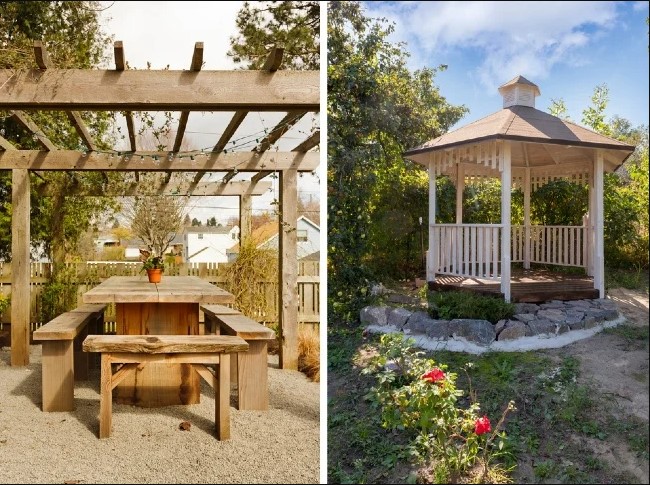
Pergola vs Pavilion
Pavilions and pergolas can enhance the aesthetics and functionality of any outdoor space. Choosing between them depends on factors like available space, intended use, and personal preference. Pavilions, being larger and more weatherproof, offer substantial shade and shelter, making them ideal for events and family activities. They can even include amenities like lights, fans, and outdoor kitchens.
Pergolas, although smaller and open, provide partial shade with a slatted top and can define seating areas or pathways in gardens. They are cost-effective, customizable, and can be adorned with climbing vines and outdoor curtains for visual appeal. While pavilions offer total weather protection, pergolas are more affordable and versatile, adding elegance to your outdoor area. The choice ultimately hinges on your specific needs, space availability, and budget considerations.
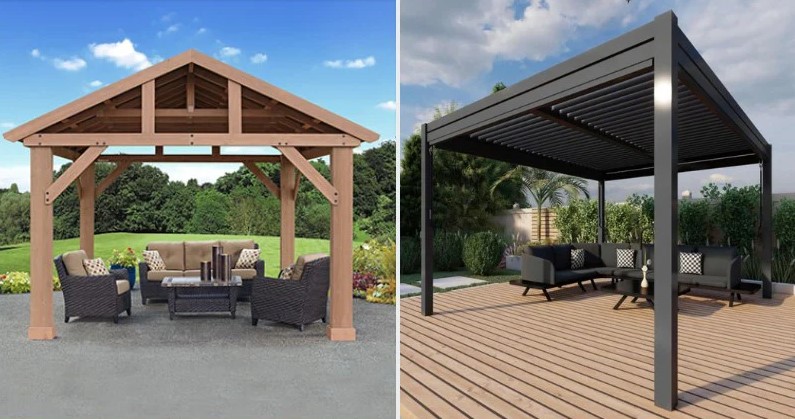
Amp Up Your Backyard Space By Choosing Between a Pergola vs Gazebo vs Pavilion
Revitalize your outdoor space with the perfect addition – whether it’s a gazebo, pavilion, or pergola. These structures bring comfort, style, and functionality, transforming your backyard into a cozy retreat. Understand the unique qualities of each, from the elegance of gazebos to the robustness of pavilions and the openness of pergolas. Make an informed choice based on your needs, space, and preferences. Create the ideal outdoor oasis that suits your lifestyle. Choose between a gazebo for intimate gatherings, a pavilion for larger events, or a pergola for a touch of rustic charm.

